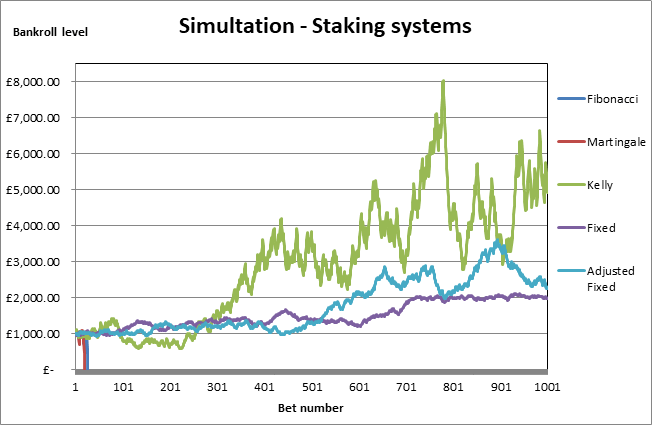
There are some famous staking systems which have been explored and we will present a theoretical-based simulation of them in order to help you choose the best staking system for you. Moreover, we will outline some practicalities to enable you to consistently make prudent decisions regarding your staking system.
What staking systems are out there?
Betting All In
Although it might seem inspiring to read about some people who turned their life around with their last £10, this is an absolutely reckless and daft approach and there is no point in considering it at all!
Fibonacci
This staking system comes from the famous mathematical sequence of the Italian mathematician. The numbers in the series are 1, 1, 2, 3, 5, 8, 13, 21, 34… The pattern is that each number is a sum of the previous two.
Martingale
Quite similar to the Fibonacci staking system. However, here every time you double your stake: 1,2,4, 8, 16. The reason why it is done is: if you hit a winner (assuming every time you bet on odds of 2.00), you would cover ALL the previous loses and make a profit. For example, if you lose your first four bets and win the 5th, you would be losing (1+2+4+8) = £15 and would gain £16 with a profit of £1. I wish it was so easy in real life!
Fixed staking system
The assumption is that you always bet the same amount (e.g. £15)
Adjusted fixed stake
This staking system is rather popular among professional tipsters actually and is very practical. Essentially, for a pre-defined range, you are keeping a fixed stake, based on a percentage of your bankroll.
Kelly staking system
Briefly speaking, this is considered one of the best methods, as it takes into account expectation of a win, portfolio size and you can never fully go bankrupt with it! For more details on this staking system, you can read our article about it!
Labouchere
Another progressive staking system which assumes a fixed goal (e.g. target to make £150 profit). It is thus hard to make cross-comparisons with the ones above. In reality, it is likely to yield similar results to Fibonacci and Martingale. It is considered very poor, and you will see why!
Comparison of the Staking Systems
For illustrative purposes, let’s assume
- That you have a betting bankroll of £1,000 and you are a professional bettor, who is using betting analytics and a smart bet tracker and is capable of beating the markets in the long term. However, due to your strong betting management, you know that the fair odds for the bets you make is 2.00 whereas the bookmakers are only offering you 2.10. Therefore, you are confident that you would make good money, as you are successful in implementing value betting!
- For simplicity, we will assume that each game you bet on has only two potential outcomes – win or lose.
Surprisingly, even if you have such an overwhelming advantage, by using an inappropriate staking system, you might incur huge loses in the long run! This is best illustrated with a simulation of a large number of bets (in our case – 1,001 bets).
Simulation rationale
- Fibonacci: You start with a bet of £10. If you lose, you bet £10, £20, £30, £50 etc. When you hit a winner, you start again with stakes of £10
- Martingale: You start with a bet of £10. If you lose, you bet £20, £40, £80, £160 etc. When you hit a winner, you start again with stakes of £10
- Kelly: You use the required formula to determine the exact percentage of your bankroll on each bet: (0.5(2.1-1))-(0.5(2-1))/1 = 5%
- Fixed stake: each bet is worth £20
- Adjusted fixed stake: you bet 2% of your bankroll (rounded up). For example, if your bankroll is £1,022, we will round it up to £1,100 and hence bet £22.
Results

As we can see, if we have an edge over the bookmakers, even if we hit a poor run, we can recover quickly by using the Kelly staking system and gain good money in the long-run! However, by being reckless and using progressive staking systems like Fibonacci and Martingale, we could quickly lose our precious betting bankroll!
The Verdict
Given the current results from a large sample of bets, we can confidently conclude two things:
- Progressive staking systems will run you to the ground, even if you are a prudent bettor. Thus, we can confidently say that Labouchere, Martingale and Fibonacci are the top 3 worst staking systems (we can argue about the order – it is not relevant at all though!). Given they are so awful, why are we even talking about them?
The sad reality is that there are a lot of self-proclaimed tipsters who advise their followers to engage in challenges such as – say turn £10 to £1000 with 20 consecutive bets (just search on twitter and you will see a lot of such “advisors”). The reason is that they win money the more their followers lose! They are by all means requesting people to use a PROGRESSIVE STAKING SYSTEM! Stay away from such scams and report them if you can!
- Adjusted staking seems to appear better than the Fixed staking system, as it takes into account the size of your bankroll. However, Kelly looks superior to Adjusted staking, as it takes into account both expected value and the size of your betting bankroll. This is the reason why professional tipsters these staking systems when they advise their followers! For simplicity, most tipsters use units – thus you can be confident that if an advisor always bets with a flat stake (e.g. 5 units) or has some system in place (for instance – I am using 3/5/7 units for the prediction I am sending to my private clients, depending on how confident I feel)
Theoretical results for staking systems: #1 Kelly Staking System #2 Adjusted Fixed Stake #3 Fixed Stake #4 Labouchere, Fibonacci, Martingale (Miles away from Fixed stake) #5 All in (Miles Away from the four above.
Does Staking Systems Work So Well in Reality?
Unfortunately, things with staking systems are not so simple when you start putting your money in bookmakers:
A. If you religiously follow the Kelly staking system, you are increasing your chances to have your account limited. Betting with round numbers (e.g. £52.65) is always alarming to bookmakers’ betting analytics teams!
Remedy: use whole numbers to avoid getting limited (e.g. bet £53 instead of £52.65)
B. Estimating fair value is not that simple – one of the biggest stumbling blocks is that in fact, even if you are great at implementing value betting into account numerous factors when calculating betting odds, estimating risk with precision is not all that easy.
The Kelly staking system is also promoting taking on excessive risk. As we saw in our example, the Kelly criterion recommends us to bet approximately 5% of our bankroll if we believe that the fair odds should be 2.00 and the bookmaker is giving us 2.10! In reality, this is a very high percentage!
Most professional bettors I know, who have been in the business for more than a decade and made a fortune from it, would never bet more than 5% of their bankroll. Even in cases when they believe the correct odds are 1.40 and the bookmakers are offering them 3.00, they would not bet above 5% of their designated bankroll. The Kelly staking system in that specific case would suggest you should stake 85.71% of your betting bankroll – this is too much risk!
As a practical benchmark, you can compare the odds you have staked on to the ones Pinnacle Sports offers just before kick-off. For example, if you bet on Everton to beat Swansea at odds of 1.90 and Pinnacle closing line for Everton win is 1.75 – in that case, you have indeed gained an edge over the market, even if you lost your bet! In reality, only 1% of bettors managed to beat the closing lines of Pinnacle Sports. Being a professional bettor is not easy at all!
C. Using the Kelly staking system, you are also quite vulnerable to losing streaks, as after your poor run is over, you will have a much lower bankroll to recover your loses.
Final Thoughts
Although applying the <Kelly staking system in practice has its drawbacks, we should definitely consider using it, albeit with lower percentage (e.g. if Kelly recommends you to stake 7% of your bankroll, go for 20% of that i.e. 1.4%). The reason for using that staking system it makes us more disciplined and conscious and helps us think about two crucial factors:
- The current size of our bankroll. It could be an arduous task to keep track of how much money you have in you bookmakers but using a smart bet tracker can automatically take care of that!
- The risk we are taking on every time we invest in a sport event. Every time you stake, you can lose. Use auto bet tracking to learn from your mistakes and think about whether you can afford to invest at all!



